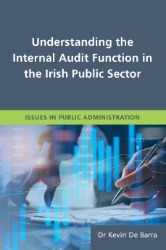 In recent years, the role of the internal audit function has gained increasing prominence. It is now seen as a cornerstone in the overall governance of public sector bodies. To understand how the internal audit function is executed in the Irish public sector, this book explores the approach set out in agency theory literature.
In recent years, the role of the internal audit function has gained increasing prominence. It is now seen as a cornerstone in the overall governance of public sector bodies. To understand how the internal audit function is executed in the Irish public sector, this book explores the approach set out in agency theory literature.
Informed by a comprehensive literature review, a study of 127 public sector bodies was undertaken. The findings from this study offer insight into the distinct perspectives of board chairpersons and CEOs across various themes relevant to the execution of the internal audit function. Among the most significant findings is that the function is not viewed by its most key stakeholders as a primary driver of continuous improvement within their organisations.
The findings also reveal that outsourcing of internal audit services is common across the sector, which gives rise to many practical consequences. Several key insights illuminated by the study have practical implications for public sector bodies seeking to realise more meaningful results from the efforts currently directed towards the internal audit function.
The author concludes that an overemphasis on assurance activities can be to the detriment of the other value-add functions that the internal audit function can deliver. While the internal audit is currently widely viewed as a divorced function, its real value will be realised only by integrating it within the organisation. Such integration will allow the sharing of enterprise-wide learning, thus enabling the function to become a primary driver of a permanent culture of continuous improvement.
Contents
List of Figures
List of Tables
Chapter 1: Introduction
- Purpose of the Book
- Adopting an Agency Theory Approach
- Context and Operating Framework
- Structure of the Book
- Research Problem
- Research Objectives
- Research Methodology
- Findings
Chapter 2: Literature Review
- Introduction
- The Internal Audit Function as a Product of Agency Theory
- Evolution of Internal Audit and Emerging Themes
- Key Topics from the Internal Audit Literature
- Practice variation
- Reporting structure
- Size and resource model
- Quality and effectiveness
- Adherence to recognised standards
- Integration with risk management
- Framework of Analysis
- Summary
Chapter 3: Research Methodology
- Research Design
- Sampling frame
- Survey instrument
- Data collection process
- Access, Ethics and Informed Consent
- Comparison to Global Norms
- Cleansing of Response Data and Preliminary Analysis
- Summary
Chapter 4: Findings and Analysis
- Resourcing of the Internal Audit Function
- Internal Audit Strategy
- Risk Management
- Quality Assurance and Improvement
- Implementation of Recommendations
- Access Arrangements
- Monitoring and Reviewing
- Summary
Chapter 5: Principal/Agent Perspectives
- Introduction
- Key Insights from Principals and Agents
- Added value
- Assurance
- Continuous improvement
- Independence and objectivity
- Risk management, internal control, and governance
- Suitability
- Differentiating Between the Perspectives of Principal and Agent
- Summary
Chapter 6: Conclusions and Implications
- Introduction
- Summary of Key Findings
- Significance and Implications of the Findings
- Limitations
- Contribution to Knowledge
- Opportunities for Future Research
- Summary
Acknowledgements
References
Appendix: Sampling Frame
Index